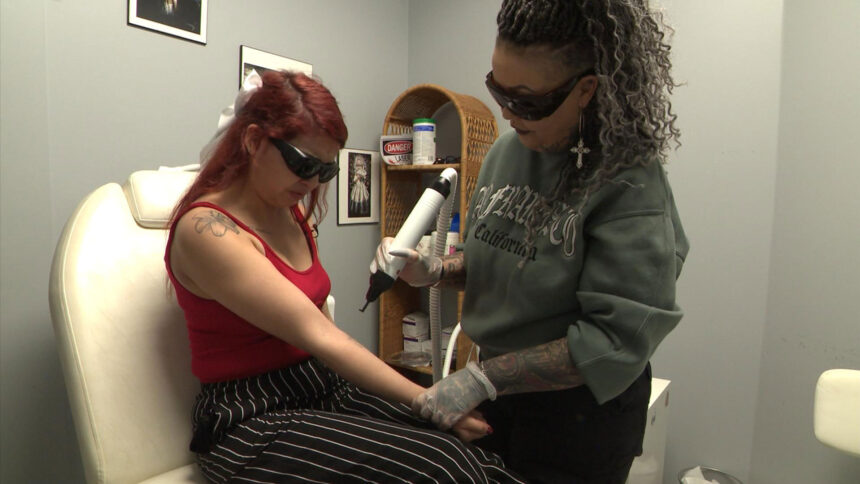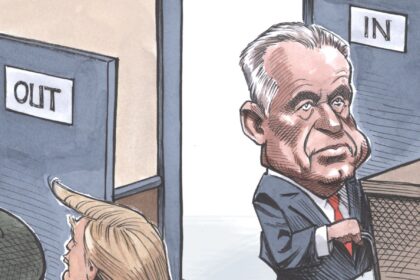A tattoo across Billie Kozub’s forehead resembles life forged in the streets. A constant reminder of a dark time filled with gang violence and addiction. It’s a past she wants to erase. “I really want to change my life but every time I look in the mirror, I just see the old me,” she told APTN Investigates. “You see a face tattoo, you’re right away wondering who they’re with or are they going to have problems.” Every day, before she starts work, Kozub uses makeup to cover her gang-affiliated face tattoo which reads “Savage Diamond.” The 42-year-old mother of two is a housing support worker at Wahbung Abinoonjiiag, a non-profit organization in Winnipeg’s north end that offers a safe space the community can access supports. It’s Kozub’s first job since reintegrating back into society after being in and out of jail for most of her life. “I love it. I’m doing community outreach and I’m going into the community and just helping the people that need help,” she said. The north end is where Kozub hustled. She was a gangster; a life that started when she was 12 and was lured at school by older men. “Guys with cars, pounding bass. I was intrigued by it. Then you start meeting them and looking up to them. They start saying they’re going to take care of you,” she said. It led to Kozub’s doing crime. At 13 years old, she recalls being asked to go into a residence to remove shotguns from an attic. “I put all these shotguns into this pillowcase,” she said. “What if those things were loaded?” It isn’t something she thought of at the time. For Kozub’s, having a sense of belonging, some kind of a family was more important. “I had problems feeling like I fit in at home because my dad was white Ukrainian, my mom was Aboriginal so there was that battle between each other there so I felt I didn’t belong in either household,” she said. Kozub’s last conviction was a breaking point. In 2022 she was charged with accessory after the fact to murder and aggravated assault. A story, she said, that is too difficult for her to tell. “That’s what changed my life,” she said, “I was just ashamed and embarrassed to even be tied to that.” Indigenous women continue to be overrepresented in all levels of Canada’s criminal justice system making up nearly 50 per cent of overall prison populations in the country. For the most part, women join a gang to seek acceptance, protection and a sense of purpose. A common cycle for Indigenous women with intergenerational trauma stemming from colonization. Erasing the past ‘I’m leaving that lifestyle behind,’ says Billie Kozub. Photo: Tamara Pimentel/APTN. Kozub is breaking that cycle by having her tattoos removed. She makes frequent visits to Mother Ink, a tattoo removal project created by Della Steinke. Funded by the City of Winnipeg and Manitoba, Steinke removes tattoos for free. The service is open to people exiting the gang life, or violence in general. She even brings her tattoo removal machine behind bars to inmates getting ready to be released. It’s the only service like it in North America. Ninety per cent of Steinke’s clients are Indigenous she said. She said she thought of the idea while working at federal halfway houses in Winnipeg. “They started telling me that it was because of these tattoos that they weren’t leaving the yard. They were scared to either get jumped back in by their old gang or get jumped by a rival gang,” Steinke said. The tattoo removal process is painful and takes many appointments for the laser treatment to break down ink particles. “Getting these removed, it’s kind of like shedding snake skin like I’m leaving that lifestyle behind,” Kozub said. Steinke said the most common story she hears from female clients is, “they didn’t choose to get these tattoos.” Michele Holmes, 21, is another client of Mother Ink. An upside down cross between ger eyebrows is faded after serval appointments, but the ink on her forearms are still visible, bringing recurring memories of sexual violence. “These are the ones I got through rape,” she told Steinke at her most recent visit, “I just want to get them removed.” Holmes said she was never in a gang, but was influenced by the lifestyle when she left her foster home at 17 years old. “It’s a very predatorial atmosphere. I was exposed to that type of behavior,” She said while driving down a residential street in Winnipeg’s north end. We pulled up next to an empty lot, where a house once stood. She said she was jumped and beat up in that house five years ago. It was all caught on video and recently made its way back on social media. Youth she thought were her friends demonstrated gang-like behaviour. “They kept me in this house for about four and a half hours. Burning me with cigarettes and they were beating me up. I lost consciousness,” she said. Holmes is three years sober, working to get her life back on track and gain custody of her child. “Choose your circle wisely because they will influence you 100 per cent,” she said. A lack of support While she prepares for school, Sarah Osborne goes back to her home community of Norway House Cree Nation to share her story with youth. Photo: Tamara Pimentel/APTN. On the outskirts of Winnipeg is a bus stop known to anyone released from Headingly Correctional Centre, Manitoba’s provincial prison. Kozub said it’s where everyone gets dropped off, including herself. Many times. With only a bus ticket and some change, she was sent back out into the streets. “There’s no guidance once you’re out either,” she said, “You’re just dropped off at that bus stop and that’s it on the way you go.” Kozub said she was able to access more support in federal prison. Sarah Osborne, 39, told APTN she witnessed women getting dropped off at the bus stop a few times while being driven to court. “They go back to the same stuff, back to the same thing until they get caught again,” Osborne told us from a Winnipeg halfway house she is staying in while on probation, “A lot of the girls are like ‘I had nowhere to go’ so they go to the last places they were at.” She spent time in provincial prison, but she said it took a bigger crime and a longer sentence in the federal system. Osborne was convicted of manslaughter. “I’m kind of glad I went to jail when I did. And I’m glad I’ve been in jail as long as I have been in jail. I took advantage of everything I could, she said, I did everything I could in there.” A March 2025 report from Manitoba’s auditor general states ‘supports for inmates transitioning from custody to the community is lacking’ and there is ‘little evidence of connecting inmates to outside resources.’ For Cathy Cook, executive director of Wahbung Abinjoonjiiag, it’s about prevention and building relationships with inmates, while they are still incarcerated. “Corrections is a consequence to an action, but again we have to look at why those actions were performed,” she said while providing lunches to people living in an inner-city encampment. “So often times our women were born into poverty. We talk about statistics, we’re one in four times more likely to be murdered or than any other, anybody else in Manitoba.” Two years ago, the Winnipeg Police Gang Prevention Unit launched a campaign to help youth escape the gang life. It is spearheaded by Const. Michelle De Groot. “I do find that these youth though, or even the ones that are in custody at Manitoba Youth Center or Headingly, they are in so desire for support that they’re willing to forget that we’re police officers,” she said. The unit is visiting schools to speak about what gang life is and what gang members look for. De Groot also partnered with Mother Ink. “We’re all looking for a sense of belonging,” Steinke added, “Whether the people that we’re choosing to hang out with are doing good or bad, still makes us feel like we’re part of a family.” Osborne said she wasn’t gang affiliated, but yearned for a family. “Well, growing up I was just, I grew up with my parents partying all the time,” she said, “I didn’t have that protection that I needed from my brothers.” Michele Holmes in the chair at Mother Ink. Photo: Tamara Pimentel/APTN. She turned to her street brothers and co-accusers in the homicide she was convicted in. Their names are tattooed on her arms with jail ink made of soot and pencil crayon. “They were like the brothers I’d never had,” she said. “I just kind of made that decision to get them (the tattoos) removed. Whatever I got to do to get out and stuff like that and continue on this path and walk this journey in a good way.” In August, Osborne continues her education with Eternal Beauty Institute for the Body and Facial Piercing Program. While she prepares for school, she goes back to her home community of Norway House Cree Nation to share her story with youth. Kozub has been out of prison for 16 months. In that time, she received her high school diploma, gained custody of her son, and started a full-time job at Wahbung Abinoonjiiag. She said in order to access support out of prison, you have to be motivated to turn your life around and reach out for help. “I always wanted a way out I just didn’t know how to ask for help,” she said. “Changing my life now I feel like I can smile. I feel like I can laugh. I’m being genuine. I feel like I’m being my true self. Before I couldn’t be that person.” Continue Reading
Erasing the past: Winnipeg tattoo removal service looks to help former inmates, gang members and victims of violence

Leave a Comment










